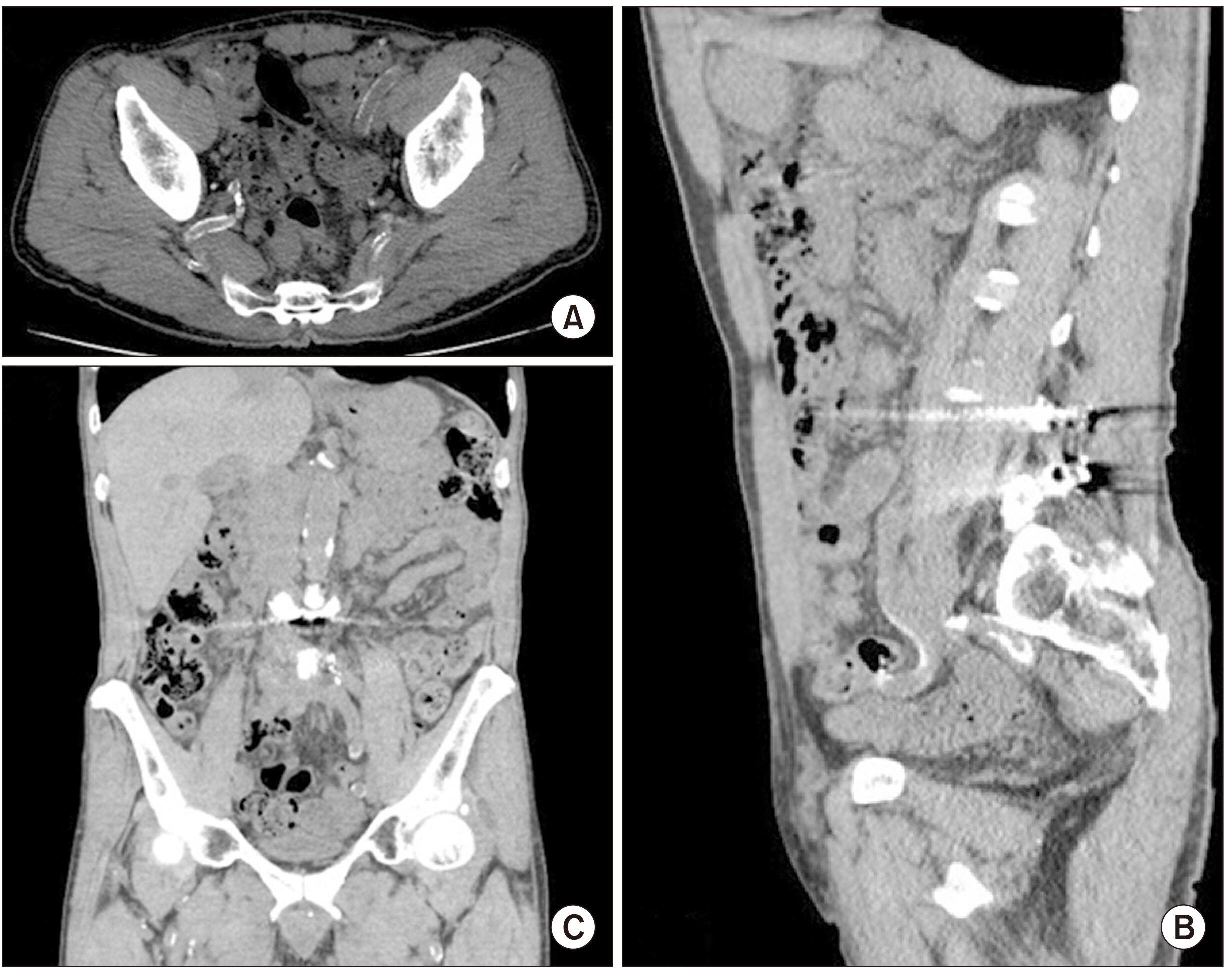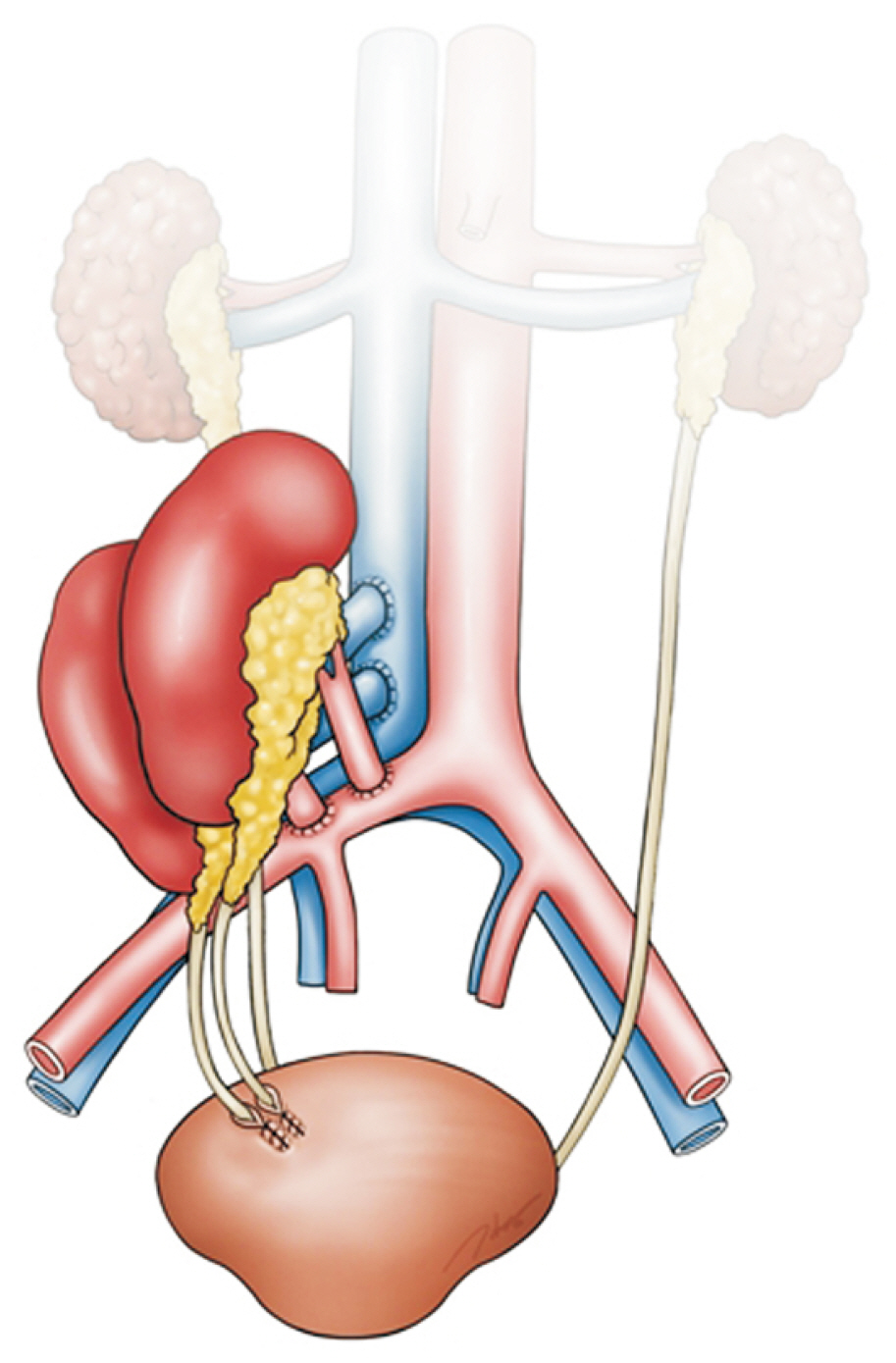Korean J Transplant.
2022 Jun;36(2):143-147. 10.4285/kjt.21.0026.
Ipsilateral dual kidney transplantation in an elderly patient with severe atherosclerosis: a case report
- Affiliations
-
- 1Division of Transplantation, Department of Surgery, Samsung Medical Center, Sungkyunkwan University School of Medicine, Seoul, Korea
- KMID: 2531138
- DOI: http://doi.org/10.4285/kjt.21.0026
Abstract
- Dual Kidney Transplantation (DKT) has been developed to improve outcomes from transplantation based on extended criteria of donors (ECD) and demonstrated excellent short-term outcomes. We performed DKT at Samsung Medical Center in March 2021. The donor was a 74-year-old male with no history of known underlying diseases but died from traumatic subarachnoid hemorrhage. The recipient was a 72-year-old male who had been undergoing nephrological observation for 4 years prior to the kidney transplant. The patient had been on hemodialysis since July 2017 and had been suffering from type 2 diabetes since 2003. On non-contrast computed tomography, diffuse calcific athero-sclerosis was observed in the abdominal aorta and left iliac artery. As a result, ipsilateral DKT was performed. Because of this diffuse calcific atherosclerosis, we planned ipsilat-eral DKT on the right side. Postoperative healing was uneventful without complications. In conclusion, DKT is an option for improving survival in the ECD pool, and ipsilateral DKT can be helpful option for preventing organ discard in ECDs.
Figure
Reference
-
1. De Serres SA, Caumartin Y, Noël R, Lachance JG, Côté I, Naud A, et al. 2010; Dual-kidney transplants as an alternative for very marginal donors: long-term follow-up in 63 patients. Transplantation. 90:1125–30. DOI: 10.1097/TP.0b013e3181f8f2b8. PMID: 20921934.2. Korean Network for Organ Sharing (KONOS). 2020. KONOS waiting list in quarterly statistics data [Internet]. KONOS;Seoul: Available from: https://www.konos.go.kr. cited 2021 Dec 20.3. Carter JT, Lee CM, Weinstein RJ, Lu AD, Dafoe DC, Alfrey EJ. 2000; Evaluation of the older cadaveric kidney donor: the impact of donor hypertension and creatinine clearance on graft performance and survival. Transplantation. 70:765–71. DOI: 10.1097/00007890-200009150-00009. PMID: 11003354.4. Bunnapradist S, Gritsch HA, Peng A, Jordan SC, Cho YW. 2003; Dual kidneys from marginal adult donors as a source for cadaveric renal transplantation in the United States. J Am Soc Nephrol. 14:1031–6. DOI: 10.1097/01.ASN.0000054494.85680.1C. PMID: 12660338.5. Metzger RA, Delmonico FL, Feng S, Port FK, Wynn JJ, Merion RM. 2003; Expanded criteria donors for kidney transplantation. Am J Transplant. 3 Suppl 4:114–25. DOI: 10.1034/j.1600-6143.3.s4.11.x. PMID: 12694055.6. Johnson LB, Kno PC, Dafoe DC, Schweitzer EJ, Alfrey EJ, Klassen DK, et al. 1996; Double adult renal allografts: a technique for expansion of the cadaveric kidney donor pool. Surgery. 120:580–3. DOI: 10.1016/S0039-6060(96)80002-X. PMID: 8862363.7. Khalil MA, Tan J, Khan TF, Khalil MA, Azmat R. 2017; Dual kidney transplantation: a review of past and prospect for future. Int Sch Res Notices. 2017:2693681. DOI: 10.1155/2017/2693681. PMID: 28752128. PMCID: PMC5511653.8. Medina-Polo J, Pamplona-Casamayor M, Miranda-Utrera N, González-Monte E, Passas-Martínez JB, Andrés Belmonte A. 2014; Dual kidney transplantation involving organs from expanded criteria donors: a review of our series and an update on current indications. Transplant Proc. 46:3412–5. DOI: 10.1016/j.transproceed.2014.10.025. PMID: 25498062.9. Veroux M, Corona D, Gagliano M, Macarone M, Sorbello M, Giuffrida G, et al. 2007; Monolateral dual kidney transplantation from marginal donors. Transplant Proc. 39:1800–2. DOI: 10.1016/j.transproceed.2007.05.042. PMID: 17692617.10. Lee KW, Park JB, Cha SR, Lee SH, Chung YJ, Yoo H, et al. 2020; Dual kidney transplantation offers a safe and effective way to use kidneys from deceased donors older than 70 years. BMC Nephrol. 21:3. DOI: 10.1186/s12882-019-1664-8. PMID: 31902366. PMCID: PMC6943896.11. Ekser B, Baldan N, Margani G, Furian L, Frison L, Valente M, et al. 2006; Monolateral placement of both kidneys in dual kidney transplantation: low surgical complication rate and short operating time. Transpl Int. 19:485–91. DOI: 10.1111/j.1432-2277.2006.00309.x. PMID: 16771870.12. Wolters HH, Palmes D, Heidenreich S, August C, Brockmann J, Senninger N, et al. 2005; Long-term follow-up of double kidney transplantation using a score for evaluation of marginal donors. Transpl Int. 18:453–7. DOI: 10.1111/j.1432-2277.2004.00068.x. PMID: 15773966.13. Fishman JA, Rubin RH. 1998; Infection in organ-transplant recipients. N Engl J Med. 338:1741–51. DOI: 10.1056/NEJM199806113382407. PMID: 9624195.14. Ekser B, Furian L, Broggiato A, Silvestre C, Pierobon ES, Baldan N, et al. 2010; Technical aspects of unilateral dual kidney transplantation from expanded criteria donors: experience of 100 patients. Am J Transplant. 10:2000–7. DOI: 10.1111/j.1600-6143.2010.03188.x. PMID: 20636454.15. Cocco A, Shahrestani S, Cocco N, Hameed A, Yuen L, Ryan B, et al. 2017; Dual kidney transplant techniques: a systematic review. Clin Transplant. 31:e13016. DOI: 10.1111/ctr.13016. PMID: 28544075.16. Tran KC, Li D, Taqi A, Sener A, McAlister VC, Luke PP. 2017; Dual en bloc technique for adult renal transplantation. Clin Transplant. 31:e13017. DOI: 10.1111/ctr.13017. PMID: 28523715.17. Salehipour M, Bahador A, Nikeghbalian S, Kazemi K, Shamsaeifar AR, Ghaffaripour S, et al. 2012; En bloc transplantation: an eligible technique for unilateral dual kidney transplantation. Int J Organ Transplant Med. 3:111–4. PMID: 25013633. PMCID: PMC4089291.18. Barach PR, Jacobs JP, Lipshultz SE, Laussen PC. 2015. Pediatric and congenital cardiac care. Springer;London: DOI: 10.1007/978-1-4471-6587-3. PMCID: PMC4511980.



